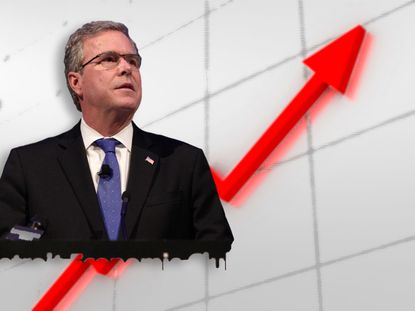Is Jeb Bush's goal of 4 percent economic growth really that crazy?
Compared to history, yes. But we're talking about the future.


When Ron Paul was running for president back in the 2012 cycle, he said that "free market" policies "will give you 10 percent or 15 percent growth or whatever." Which is, of course, absolutely ridiculous. Annual U.S. growth, adjusted for inflation, has averaged just over 3 percent since the 1950s. Only very poor nations have been able to grow their economies at rates of 10 or 15 percent for a sustained period of time, such as Asia after it opened itself to Western trade and foreign investment. Not even Paul's idealized America — pre-Federal Reserve, pre-welfare state, pre-income tax — expanded at such a warp-speed rate.
Paul's hyper-optimistic views were hardly mainstream among 2012 Republicans. But the rest of the candidates weren't exactly skittish with their own predictions. Even earnestly restrained former Minnesota Governor Tim Pawlenty was calling for an ambitious 5 percent GDP growth target.
I guess the new gaggle of Republican presidential candidates have downgraded their expectations for the U.S. economy. Because there was Jeb Bush on Monday, calling for a measly 4 percent growth rate:
Subscribe to The Week
Escape your echo chamber. Get the facts behind the news, plus analysis from multiple perspectives.

Sign up for The Week's Free Newsletters
From our morning news briefing to a weekly Good News Newsletter, get the best of The Week delivered directly to your inbox.
From our morning news briefing to a weekly Good News Newsletter, get the best of The Week delivered directly to your inbox.
So many challenges could be overcome if we just get this economy growing at full strength. There is not a reason in the world why we cannot grow at a rate of 4 percent a year. And that will be my goal as president — 4 percent growth, and the 19 million new jobs that come with it. Economic growth that makes a difference for hard-working men and women — who don't need reminding that the economy is more than the stock market. Growth that lifts up the middle class — all the families who haven't gotten a raise in 15 years. Growth that makes a difference for everyone. It's possible. It can be done. [Jeb Bush]
Democrats were quick to mock Bush's goal. They noted that growth averaged just 2 percent during his brother's presidency, which ended in economic disaster. To find a long period of rapid growth, one has to look back to the Clinton years, a point Hillary Clinton is already making. (We'll see if Republicans counter by noting that the economy grew just as fast during the Reagan boom years.)
But political potshots aside, there's good reason to doubt whether Jeb Bush or Hillary Clinton or any other politician has a magic formula for growth. The Federal Reserve, Congressional Budget Office, and Obama White House all see growth closer to 2 percent than 3 percent as a more realistic expectation for the 21st century American economy. Private forecasters see the same permanent slowdown. In a new note, economic consulting firm IHS Global Insight calls growth rates of 3 percent "relics of the past" for advanced economies like America's.
Why? Well, about half of U.S. growth in the postwar era has come from higher productivity, and half from a growing labor force. But American society is getting older and working less. Given much slower labor force growth, much higher productivity is needed to make up the difference. If productivity growth just stays at its postwar average — and it's been much slower lately — the economy's growth potential is much lower than in the past. As economics blogger Bill McBride writes, "Right now, due to demographics, 2 percent GDP growth is the new 4 percent."
But demographics aren't necessarily destiny. Returning to at least a 3 percent economy, if not a bit better, isn't impossible — it just might take a while.
First, you need to boost labor force growth. One way is by keeping older people in the workforce longer by eliminating the payroll tax for workers 62 and older. Increasing immigration would also help. Despite America's immigrant friendly reputation, our immigration rate is only half that of some other advanced economies, including Australia, Canada, and Germany.
Second, you need to boost productivity. Sorry, Republicans, but tax cuts are not enough. Making America more innovative requires everything from more startups to better infrastructure to more science funding.
Third, we need to measure GDP better. A recent Goldman Sachs report argues that metrics designed for an industrial economy are poorly suited for one driven by information technology. Productivity and GDP growth might be higher than we think: "So confident pronouncements that the standard of living is growing much more slowly than in the past should be taken with a grain of salt."
And the more innovative America becomes, the greater the chance the economy might one day grow faster than any economist imagines right now. The unknowable, unpredictable pace of technological advancement injects what the San Francisco Federal Reserve has called a "fundamental uncertainty" into the future of growth. Perhaps, the bank speculated last year, "the possibility that artificial intelligence will allow machines to replace workers to some extent could lead to higher growth in the future." Good luck programming the Singularity into your fancy ecomometric model.
So who knows, Bush's target might actually be on the low side. And Paul might have been more right than any of us realized.
Create an account with the same email registered to your subscription to unlock access.
Sign up for Today's Best Articles in your inbox
A free daily email with the biggest news stories of the day – and the best features from TheWeek.com
James Pethokoukis is the DeWitt Wallace Fellow at the American Enterprise Institute where he runs the AEIdeas blog. He has also written for The New York Times, National Review, Commentary, The Weekly Standard, and other places.
-
 What to know when planning an awe-inspiring hike on the Inca Trail
What to know when planning an awe-inspiring hike on the Inca TrailThe Week Recommends Peru's most famous trail leads to Machu Picchu
By Catherine Garcia, The Week US Published
-
 Lead poisoning remains a threat
Lead poisoning remains a threatThe Explainer The toxin is built into our lives
By Devika Rao, The Week US Published
-
 Should you use a 529 plan? What to know about this college savings option.
Should you use a 529 plan? What to know about this college savings option.The Explainer This tax-advantaged savings account can be used to pay tuition or buy textbooks
By Becca Stanek, The Week US Published
-
 Arizona court reinstates 1864 abortion ban
Arizona court reinstates 1864 abortion banSpeed Read The law makes all abortions illegal in the state except to save the mother's life
By Rafi Schwartz, The Week US Published
-
 Trump, billions richer, is selling Bibles
Trump, billions richer, is selling BiblesSpeed Read The former president is hawking a $60 "God Bless the USA Bible"
By Peter Weber, The Week US Published
-
 The debate about Biden's age and mental fitness
The debate about Biden's age and mental fitnessIn Depth Some critics argue Biden is too old to run again. Does the argument have merit?
By Grayson Quay Published
-
 How would a second Trump presidency affect Britain?
How would a second Trump presidency affect Britain?Today's Big Question Re-election of Republican frontrunner could threaten UK security, warns former head of secret service
By Harriet Marsden, The Week UK Published
-
 'Rwanda plan is less a deterrent and more a bluff'
'Rwanda plan is less a deterrent and more a bluff'Instant Opinion Opinion, comment and editorials of the day
By The Week UK Published
-
 Henry Kissinger dies aged 100: a complicated legacy?
Henry Kissinger dies aged 100: a complicated legacy?Talking Point Top US diplomat and Nobel Peace Prize winner remembered as both foreign policy genius and war criminal
By Harriet Marsden, The Week UK Last updated
-
 Trump’s rhetoric: a shift to 'straight-up Nazi talk'
Trump’s rhetoric: a shift to 'straight-up Nazi talk'Why everyone's talking about Would-be president's sinister language is backed by an incendiary policy agenda, say commentators
By The Week UK Published
-
 More covfefe: is the world ready for a second Donald Trump presidency?
More covfefe: is the world ready for a second Donald Trump presidency?Today's Big Question Republican's re-election would be a 'nightmare' scenario for Europe, Ukraine and the West
By Sorcha Bradley, The Week UK Published